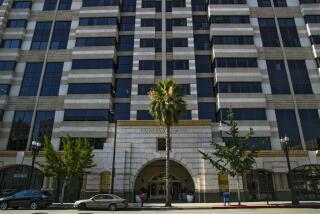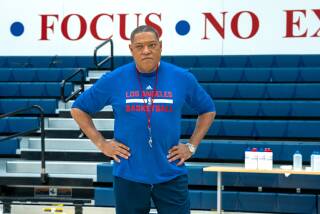Sifting Through Debris of Comparator Blowup
- Share via
The roomy Newport Beach office of Robert Reed Rogers reflects the tastes of a man who cultivates a dignified and worldly air. There are Indonesian tapestries, a replica of Egyptian papyrus and a lamp like those that once lit the cabins of the Orient Express.
But the most unsettling decoration in Rogers’ office--an uncanny replica of a ticking bomb--may be the most appropriate metaphor for the company he runs.
After ticking softly for 17 years, Comparator Systems Corp. blew up last month in an unprecedented stock market explosion that has left investigators scurrying around the country trying to pick up the pieces.
As they sift through the debris, investigators are confronting a bizarre and complex story that involves the mysterious death of a Yugoslavian prince, the transfer of millions of shares of stock in shell companies registered in Nevada, and the crucial testimony of a former Comparator executive who later became an actress in pornographic movies.
It also involves thousands of investors who made and lost millions of dollars on a company they didn’t understand, as well as the relationship between Comparator and La Jolla Capital Corp., a San Diego brokerage that is home to employees once convicted of drug charges and shoplifting, according to regulatory records.
All of this is the fallout from a money-losing maker of electronic fingerprint scanners that has spent the last 17 years in states ranging from dormancy to near death. The company survived on what federal investigators say was its one true talent: issuing stock, lots of it.
Comparator used stock to pay executives in lieu of salary, to settle debts with other companies and even to pay for the services of lawyers and dentists, according to company financial records.
Last month, with 610 million shares of stock stretching the seams of this tiny company, the volatile mix finally exploded. In three days, Comparator set three trading records on the Nasdaq Stock Market, and its shares rose more than thirtyfold in value before panicked regulators pulled the plug.
On May 31, the Securities and Exchange Commission filed a sweeping lawsuit accusing the company of fraud, and seeking to bar Rogers, Vice President Gregory Armijo and former executive Scott Hitt from ever serving as officers of any public company. Chief Executive Rogers, 67, denies any wrongdoing at the company.
Dozens of interviews with regulators, witnesses and company executives and the examination of thousands of pages of documents yield a portrait of a company with an almost animalistic will to survive, a will so strong that the company went to great lengths to protect the heavy flow of stock that was its lifeline.
For despite all the characters that populate the Comparator stage, the company’s stock is--and always was--the main player in the story.
Comparator entered the public market in July 1979 through now-defunct underwriter Blinder, Robinson & Co.--a Denver penny-stock specialist derisively dubbed “Blind ‘Em and Rob ‘Em.” The firm’s founder, Meyer Blinder, was later convicted of racketeering, money laundering and securities fraud.
Selling nearly 10 million shares for a dime apiece, Comparator raised $800,000, enough to pay deferred salaries, settle debts and put a little in the bank.
But over the next few years, Comparator failed to make any significant sale. In the first of many misleading announcements the company would make, Comparator in mid-1982 said--falsely, it turned out--that it had a $3-million deal with several African countries, according to court records and interviews.
The company’s chairman had a heart attack in the early 1980s, and after a parade of executives departed, Rogers arrived in 1983, fresh from running a metals refining research firm. By then, Rogers, whose resume includes a college professorship, had already been reprimanded by stock regulators for issuing unregistered securities.
But he was beginning a new era--and so was Comparator.
Rogers quickly hired Scott Hitt, a former gunnery sergeant and private investigator. Hitt’s title was vice president, and his then-wife, Kay Churchill, acknowledges that she “came along as extra baggage” to answer telephones and clean the office.
Churchill has emerged as the Securities and Exchange Commission’s key witness. Her testimony spans nearly 200 pages in SEC transcripts, and it is filled with accusations about illegally issued stock, secret meetings with stock promoters at a Marie Callender’s restaurant in Carlsbad, and feeding frenzies for the cash that came in from the company’s incessant private stock offerings.
*
In many respects, Churchill should know better than almost anyone. She was the company’s corporate secretary, which means she handled most of the paperwork related to the stock.
But Churchill, 49, also raises a number of problems for the SEC. She was fired from Comparator two years ago after being accused of embezzling about $800,000, an accusation she denies. Since then, she has changed her name to Summer Rayne Wolf and has appeared in a pornographic movie and in adult magazines.
“I’m embarrassed,” Churchill said. “But I had to do something to survive. I was in desperate needs and I had the sum of $1 left in my wallet.”
In her SEC testimony, Churchill says that Comparator was nothing more than a vehicle for fraud and that Rogers often told employees that “if we stay on Nasdaq, we can run the stock up; we’ll all be millionaires.”
Churchill now lives in North Carolina and said she has quit pornography to go to school to become a medical technician. She has also filed for bankruptcy protection.
Rogers says that Churchill is a thief who is feeding the SEC lies because she would like to destroy his company.
“I have no reason to lie,” Churchill said. “And I would have kept my mouth shut, but they brought this on themselves.”
By 1990, under Rogers’ leadership, the company had issued about 500 million shares to investors, employees and even a Newport Beach dentist.
“Would you be interested in taking stock in lieu of cash?” was how Rogers proposed to pay Dr. Richard Forehan, a dentist who treated several of Comparator’s top executives.
“They all had bad teeth,” Forehan said.
Those who know Rogers say he always tried to project an air of confidence and erudition, often dropping the names of regal acquaintances and telling tales of his world travels.
“He talked about how he and Hitt were in a steam room with [Soviet leader Leonid] Brezhnev’s finance man, beating each other with olive leaves and drinking vodka,” Forehan said.
Rogers, a native of Oak Park, Ill., used his impressive contacts to help pitch the company. Company documents refer to meetings with the president of Turkey and the prime minister of Malaysia.
And he said in an interview that he even enticed a Yugoslavian prince, Andrej J. Karageorgevitch, who had taken up residence in Palm Springs, to invest in the company and become its head of international sales. In one of the more mysterious developments surrounding Comparator, Karageorgevitch died, apparently a suicide, by asphyxiation in a company garage.
*
In sworn testimony, Churchill claims that company executives forged the prince’s name and cleaned out his checking account. Rogers said that is not true and insists there was no foul play.
“He was my dearest friend,” Rogers said.
Comparator appears to have undergone a dramatic transformation about 1990, just as the company was securing a coveted listing on the Nasdaq Stock Market, a crucial move that would put the company’s name in the stock pages of daily newspapers and grant access to legions of new investors.
Once inside Nasdaq’s door, the company appears to have done everything it could to stay there.
One part of Comparator’s strategy, according to the SEC, was to vastly overstate the value of its assets in an effort to remain above the minimum requirements set by Nasdaq.
While the company still had never made a profit and rarely had a sale, it repeatedly issued dozens of press releases touting new deals, new products and new financing, much of which never materialized.
Comparator also continued to tout each new generation of its fingerprint devices. But by the early 1990s, the company’s technology was said to be lagging badly, so Rogers arranged a meeting with a professor in Scotland to examine a device developed at the University of Edinburgh.
The professor, Peter Denyer, said he agreed to lend his device to Rogers, who promised to find a market for it in the United States. But the SEC alleges that once Comparator had gained hold of the device, the company marketed it as its own technology, covered by Comparator patents.
In early 1993, Comparator’s paths crossed with La Jolla Capital, a small brokerage that specializes in low-priced stock.
Over the next three years, La Jolla Capital sold tens of millions of shares of Comparator stock to at least 600 clients, according to Harold B. Gallison Sr., who with his son and an attorney founded the brokerage in 1992.
The brokerage’s leading trader in Comparator was Bill Coogle, who, along with other La Jolla Capital brokers, has been accused in a civil suit by investors of zealously promoting the stock.
In a signed statement filed in court, San Diego businessman Tom Regos said Coogle called him repeatedly in the weeks before the stock’s sudden run-up. Coogle “assured me that Comparator’s stock would increase in value because it had a great new fingerprint identification device and that MasterCard was in negotiations with Comparator to purchase the technology,” Regos said.
Coogle, 34, who works out of La Jolla’s Georgia office, in interviews and court papers insisted that he never contacted Regos. “I’ve made my clients millions,” he said. Coogle declined to say how much he earned in commissions for trading Comparator, but he said it was enough to buy a new car--and more.
But longtime investors of Comparator--including the many who accepted company stock in exchange for services--weren’t so lucky.
Winfield Salisbury, a physicist, was one of the scientists hired by Rogers. Salisbury flew to Malaysia and lingered there for months waiting for his lab to open. But it never did.
For his services, Salisbury received about 900,000 shares of stock. Now 92, Salisbury had long given up on the stock ever going anywhere. And when the stock surged, he and his family missed the window to cash out.
*
To some, one of the most troubling aspects of the Comparator story is that there were so many red flags raised throughout the company’s history. Yet regulators failed to act until the stock had run up and investors had lost millions of dollars.
“It’s a big stock market with thousands of listed companies,” explained Richard Sauer, the SEC’s lead investigator in the case. “There are a limited number of investigators, and there has to be a prioritizing of every company we look at.” “
Even as the SEC proceeds with its civil suit against Comparator, investigators continue to search for answers to such basic questions as what started the trading frenzy and whether any Comparator insiders profited from it.
Rogers, who once helped edit a book issued in the 1970s under the title: “The Book on Offshore Wealth,” insists none of the company’s executives sold any Comparator shares during the frenzy. He acknowledges that he transferred millions of shares of Comparator stock to a number of Nevada-registered companies that he controls.
Comparator’s stock remains frozen at 56 cents per share, and thousands of investors are waiting to see what will happen when trading resumes, if it ever does.
More to Read
Sign up for Essential California
The most important California stories and recommendations in your inbox every morning.
You may occasionally receive promotional content from the Los Angeles Times.













